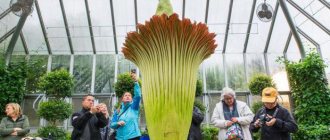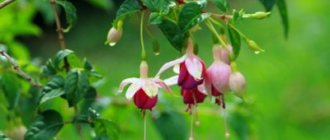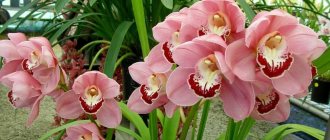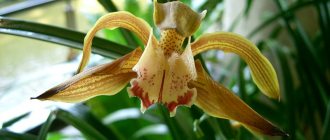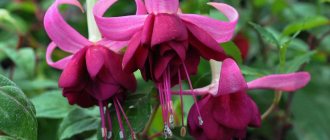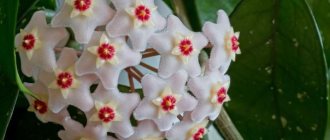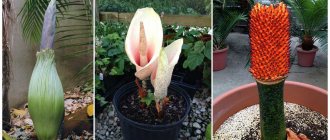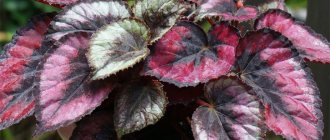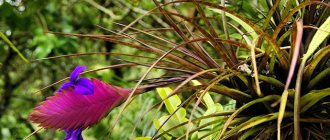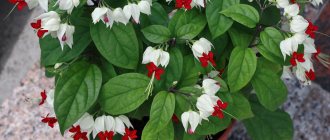- Amorphophallus bulbous or bulbous (bulbifer). The tuber is small (7–8 cm), similar to a ball cut in half. The length of a single leaf is about 1.5 m. Small tubers develop at both ends of the petiole. The length of the bedspread is approximately 20 cm, the inflorescence is 30 cm. The outside of the petal at the base is reddish, from bottom to top this shade gradually changes to greenish-pink. The inside is lime color. The ear is white-yellow, pointed upward. The boundary between male and female flowers is clearly visible.
- Amorphophallus cognac (konjac). The tuber is in the shape of an almost regular ball with a diameter of about 20 cm. Leaf length is up to 1 m. Peduncle height is 70–80 cm. Olive-colored petioles with lighter and darker spots. The blanket does not completely cover the cob, being approximately half as long (about 25 cm). The plant owes its name to the national Japanese dish “konjaku”, which is prepared from its tubers. Most often used in oriental medicine.
- Amorphophallus bell-shaped (campanulatus). The leaves are round, dissected into three lobes, approximately 25–30 cm in diameter. The spadix is short, the spathe is almost four times shorter. The petal shimmers in shades of deep purple and inky violet.
- Amorphophallus rivera (rivieri). Very large (up to 30 cm in diameter and up to 5 kg in weight) tubers. The length of the wide leaf, similar to a fan, is about 1 m. It is divided into three lobes, each segment, in turn, also pinnately dissected. The petiole is covered with pale green or dark brown spots. The length of the inflorescence and the spathe are approximately the same. Sticky drops form on the cob. The shade of the petal changes from dark scarlet at the base to almost black with a purple tint.
- Amorphophallus titanium (titanum). Fully lives up to the name. Tuber diameter is 45–50 cm, weight is up to 50 kg. The leaf is round, cut into 3 parts, about 3 m high and wide. The length of the petiole, covered with transverse whitish strokes, is up to 5 m, thickness is 10 cm. The cover (70–80 cm) is soft green on the outside, chocolate and red-violet on the inside. low tide The length of the cob is more than 2 m, about 5000 flowers bloom simultaneously. Amorphophallus titanica has been the official symbol of the Indonesian Botanical Garden for more than 120 years. Currently, it is practically not found in nature. Each specimen in greenhouses or botanical gardens has its own unique name and is the object of the closest observation by scientists.
- Amorphophallus paeoniifolius. The popular name is “elephant yam”. The mass of the tuber is up to 15 kg, diameter is 30–40 cm. The cover is lilac-green, the upper edge looks like a frill. The petiole is very short, which is why the inflorescence looks like a mushroom. Like the lower part of the petal, it is covered with spots. Sheet diameter is from 0.5 to 3 m.
- Amorphophallus dwarf or pygmy (pygmaeus). Very popular among gardeners due to its size. Height - no more than 0.5 m. The inflorescence is snow-white, very elongated, the cover is the same color. The unpleasant smell lasts only the first night after the flower blooms. The leaves are a very dark green color, and from a distance they can easily be mistaken for black.
Photo gallery: amorphophallus grown at home
A unique feature of Amorphophallus bulbiferous is the formation of tubers at the ends of the petiole The name of Amorphophallus konjac comes from the national Japanese dish, despite the fact that the first association is with an alcoholic drink Amorphophallus campanulata has a rather short spathe Amorphophallus rivera is often found at home There are very few plants for which the name fits larger than Amorphophallus titanica Amorphophallus pionifolia is a rather atypical representative of the genus Amorphophallus dwarf, compared to its relatives, it has very modest dimensions
How to create the right microclimate for a plant
The climate in the homeland of amorphophallus is very different from the conditions of modern apartments. In order for the plant to feel good and bloom regularly, you should listen to its “wishes” and create an atmosphere at least close to optimal. It is quite unpretentious - it tolerates temperature changes, drafts, and is undemanding in terms of lighting.
Some gardeners specifically place a pot of amorphophallus in partial shade. A slight deficiency of light deepens the shade of the leaves - it becomes very rich, dark green. A reddish border appears along the edges.
Where the climate allows, amorphophallus is grown outdoors, in large tubs or in open ground. The plant effectively complements the landscape design. In Russia, it can be taken out into the open air only in summer, providing protection from bright sun, cold drafts and rain.
Amorphophallus is undemanding to lighting; sometimes it is specially placed in light partial shade.
Table: optimal conditions for growing amorphophallus
| Factor | Recommendations |
| Location | Next to a window facing southeast or southwest. There must be curtains on the southern windowsill. |
| Lighting | The flower, in principle, is undemanding in terms of lighting. The best option is bright, but diffused light with shading from direct sunlight. During the dormant period - partial shade or even complete darkness. |
| Temperature | During the active growing season - 20–23ºС, during winter rest 11–13ºС (in no case higher). Below 10ºС - and the plant will die. |
| Air humidity | It tolerates the dry air of modern apartments, but prefers high humidity. It is advisable to spray the flower at least once a day. At the same time, this is a useful hygienic procedure and prevents the appearance of pests. |
Aroma of amorphophallus
The snake tree exudes a fetid aroma of rotting meat and rotten eggs. In this way, it attracts flies, which act as pollinators. Because of this, people called it the “corpse flower.” The indoor snake tree stinks only when it blooms, the rest of the time it does not smell. In apartment living conditions, it blooms rarely, approximately once every 3–4 years. The plant emits the strongest smell in the first three days of flowering, and after that its “aroma” decreases and disappears completely.
Transplant procedure and preparation for it
Since amorphophallus has a clearly defined dormant period, transplantation for it is an annual procedure. It is carried out in early spring, as soon as the growth point begins to swell. It is necessary that the container is 2-3 times wider than the tuber. The diameter and height of suitable pots are approximately the same. The preferred material is ceramics; such containers are more massive and therefore more stable.
Amorphophallus is replanted every year as soon as the tuber begins to show signs of awakening
The main requirement for soil is looseness and nutrition. There is a special soil for sale for Aroids, but you can mix the substrate yourself:
- fertile turf, leaf soil, peat chips, humus, coarse river sand (equal parts);
- universal soil for indoor plants, rotted compost or powdered dry manure, peat, sand (1: 1: 1: 0.5);
- garden soil and sand (4:1). A useful additive is superphosphate (20 g per 3 liters of the finished mixture).
Transplant procedure
- Cover the hole for water drainage with a ceramic shard, fill a third of the pot’s volume with coarse sand, brick chips, and fine expanded clay.
- Add freshly prepared disinfected substrate (up to half the height of the container).
- Inspect the tubers. Cut rotten or dried areas back to healthy tissue with a sharp, clean knife. Treat the “wounds” with iodine, brilliant green, or sprinkle with crushed chalk, activated carbon, and cinnamon. Let dry for 2-3 hours. Experienced flower growers, in order to minimize the risk of infection, recommend immersing the knife in boiling water after each cut.
- Make a hole in the soil and fill it with sand. Immerse the bottom third of the tuber in it.
- Add soil around the edges, gently shaking the pot occasionally. Make sure that the growing point remains above the soil surface.
- Water the plant moderately and place it where it will receive diffused bright light.
- During the season, add soil several times - “offshoots” and new roots form closer to the top of the parent tuber.
The transplanted amorphophallus first forms a flower, then a leaf
Landing rules
Amorphophallus tubers are replanted in the spring every 1-2 years. The roots begin to appear in their upper part, so planting is done deep enough. The pot must be at least twice the size of the tuber and be stable. It is necessary to make a hole at the bottom of the container and pour a thick layer of drainage material (expanded clay, shards, pebbles).
The soil for planting must have a neutral or slightly alkaline reaction. To compose the soil mixture, the following components are used:
- leaf humus;
- turf land;
- leaf soil;
- peat;
- sand.
It is useful to add a little charcoal and pieces of pine bark to the soil. If the children are not separated before awakening, they form bright shoots under the mother plant. This will not harm him, but you should take care of free space in advance.
Important care details
Even a novice gardener can grow amorphophallus. You just need to study the rules for caring for a flower in advance - its needs vary greatly depending on the time of year. The plant has a pronounced dormant period. A “resting” flower does not need frequent watering and does not require fertilizers.
Watering
A newly transplanted plant is watered moderately, and a plant that has begun to grow is watered abundantly. During the entire period of active growing season, the top layer of soil is allowed to dry out only slightly. Usually one procedure every 2-3 days is sufficient.
A plant that has emerged from hibernation needs abundant watering and regular feeding.
Try not to pour water directly on the tuber - this provokes the development of rot. Continue watering until it seeps into the pan. From there, excess water will need to be drained after about 45–60 minutes.
For watering and spraying, which the flower loves very much, use only soft water heated to room temperature. Tap water must be passed through a filter, boiled or left for 1-2 days with the addition of a small amount of citric acid or apple cider vinegar (a few crystals or drops per 10 liters).
Fertilizer application
Fertilizing begins a month after the first shoots appear. Frequency: once every 10–15 days. About half an hour before the procedure, the flower should be watered generously. Amorphophallus most strongly needs phosphorus, which is necessary for tubers to increase mass.
When purchasing liquid complex fertilizers, pay attention to the dosage of elements. The optimal ratio of phosphorus, potassium and nitrogen is 4:1:1 or at least 3:2:1.
When choosing fertilizer for amorphophallus, pay attention to the composition
The flower also reacts positively to natural organic matter. You can alternate such fertilizers with mineral ones. The plant is watered with an infusion of rotted cow manure or bird droppings diluted with water (in a ratio of 1:20 or 1:10, respectively).
Rest period
Most amorphophallus stop growing at the beginning of autumn, and the leaves gradually fade. As soon as it dries completely, it must be cut as close to the soil surface as possible. The rest period lasts 5–6 months. There are different recommendations regarding the tuber - leave it in a pot or dig it up.
The dormant period of amorphophallus lasts 5–6 months
When the first signs of wilting appear, watering is gradually reduced and fertilizing is stopped immediately. If the tuber remains in the pot, in winter the soil is very sparingly sprayed with water every 15–20 days.
You can also cut off the leaf and carefully remove the root from the container. The substrate is sifted - there may well be “offsprings” there. Dried, dead and rotten tissues are removed. To disinfect, tubers are placed in a deep pink solution of potassium permanganate for 2–3 hours. Then they need to be dried well and stored in a cool, dry, dark place. Most often they are stored in a box, wrapped in a napkin, covered with sand or peat.
Views from photos
Today there are more than 100 different subspecies. Let's look at the most common types of Amorphophallus flower, photos of these varieties.
Cognac (A. konjac C. Koch)
It has a flattened planting tuber, reaching 7-25 cm. It has only one large leaf, reaching 20 cm. The leaf fibers are very large. They have three separate segments. In the first order, they reach 50 cm in length. They have a divided forked surface.
Subsequent segments are oblong, in the form of ellipses. They have rounded edges. They reach 2-8 cm in length. The segments at the apex are pointed. The leaf veins are emerald, convex. The petiole is elongated, emerald-brown. Has snow-white spots. It reaches 40-80 cm in length. The peduncle is elongated. It reaches 50-70 cm in length.
The bedspread is elongated, round, 20-30 cm long. It has a purple tint inside. The cob is twice as narrow and longer than the spathe. It reaches a length of more than 50 cm. During flowering it can heat up to 40°C. It has a bright bloody or lilac hue. Has a pungent odor. Doesn't bear fruit. The birthplace of the flower is considered to be China and the Philippines.
Find out more about this species here
Titanic (A. titanum)
Grass giant. Found in the tropics of Sumatra. The diameter of the tuber reaches 1.5 m, weight 23 kg. Has a period of rest. In spring, a peduncle 50-70 cm long appears from the soil.
At the age of 5 years, the plant can begin to bloom. A small red inflorescence forms at the top. The spadix has both male and female flowers. The plant has a burgundy-brown cape.
REFERENCE: The length of the cob can reach more than 70 cm. In wild conditions it grows up to 4 m.
The plant has a strong unpleasant odor. It attracts pollinating insects. Flowering lasts 13-15 days. In this case, the cob is heated to a temperature of 40°C. During flowering, the tuber is greatly depleted. The lifespan of a flower is about 40 years. The tropical forests of South Africa are considered to be their homeland.
More information about the titanic species
Praina (A. prainii)
It has a compressed tuber, reaching 8-25 cm in diameter. The petiole is elongated 10-210 cm. Leaves are 1.5-10 cm long. The leaf blade is pinnate. The bedspread is elongated, reaching 10-25 cm.
The outside has an emerald-amber tint. The inside is completely snow-white. The base of the bedspread is brown. The ear is beige in color, reaches 9-35 cm. The plant is common in Malaysia.
Abyssinian (A. abyssinicus)
Herbaceous tuberous flower. The tuber has rounded convex edges. It reaches 4.5-31 cm in diameter. The rhizome is elongated to 30 cm. The leaves are formed after the inflorescence appears. The leaf blade has three sections. It reaches 20-100 cm in diameter.
The vein is winged, sharp. The petiole is elongated, 20-95 cm long. May be emerald or burgundy. Has small lilac spots. The leaves are oblong, lanceolate. Single inflorescence. The peduncle is shortened. The spathe is elongated in length and reaches 14-38 cm. The spadix is sessile, 8-30 cm long.
WARNING: The flower has the smell of rotten fish or excrement.
In good conditions the plant bears fruit. The diameter of the berries reaches 0.6-0.8 cm. South Africa is considered to be its homeland.
White (A. albus)
Grows in arid thickets. It has a voluminous round tuber, reaching 7-10 cm in diameter. The leaf is single. The petiole is long, smooth, emerald. Has small snow-white inclusions.
The leaf blade reaches 80 cm. The inflorescence is single. The diameter of the peduncle is 1-2 cm. The spadix is sessile, curved. Has a male and female phase.
Leafless (A. Aphyllus)
It has a flat, wide tuber from which round shoots extend. Leaves are formed after the inflorescence. They reach 30-80 cm in diameter. The vein is narrow and winged. Cataphylls in the amount of 3-4 pieces. They have an elongated peduncle. Inflorescence shortened, single.
The spathe is separate, reaches 6-25 cm in length. The spadix is 5-23 cm long. The female zone is conical, the flowers are crowded. The ovaries are elongated. The infructescence is cylindroconical. The plant grows in Sinegal.
Typical gardener mistakes
The main problems for a novice gardener are related to the need to adjust watering. In soil turned into a swamp, the amorphophallus tuber quickly rots. Other errors in care negatively affect the decorative appearance of a single leaf.
Table: how errors in care manifest themselves and what causes them
| What does the plant look like? | What is the reason |
| Quickly spreading black “wetting” spots on the tuber and at the base of the petiole. | Too frequent and/or excessive watering. The situation is aggravated by low indoor temperatures. |
| Drying leaf. | The plant does not have enough fertilizer or the air in the room is too dry. |
| Darkened leaf. | The flower does not have enough light. Sometimes it is placed in partial shade specifically to achieve this effect. |
| Light spots of irregular shape on the leaf. | Amorphophallus received sunburn. This happens especially often if a freshly sprayed plant is standing in the sun - drops of water focus the rays. |
Growing problems
Various diseases when growing indoor amorphophallus flowers occur if proper care is provided and suitable conditions are provided. Only rarely can you encounter the following problems:
- Loss of leaf color. This is the main sign of insufficient lighting. It is necessary to move the container to a brighter place.
- Drying of leaf tips during the active phase. May be caused by insufficient watering or too dry air.
- Root rotting. It speaks of stable overflows or that the drainage layer in the pot should be larger. The tuber must be urgently removed, dried and planted in new, disinfected soil.
Exotic is resistant to pests. Parasites dangerous to amorphophallus are aphids and spider mites. This is observed only in the vegetative phase in dry air, in the vicinity of infected plants. For prevention, increase air humidity or wipe the foliage with a damp sponge. If the intensity of the disease is high, it is necessary to apply insecticides and acaricides at least 3 times every week.
Diseases and pests: how to recognize and fight
Amorphophallus is resistant to most diseases typical of indoor plants. The exception is root rot. It is also relatively rarely affected by pests, but it still happens. Therefore, you need to know what to do to cope with the problem.
The risk of infection can be minimized by following preventive measures:
- quarantine for newly acquired plants and immediate isolation of specimens with suspicious symptoms;
- placing indoor flowers and bouquets as far from each other as possible;
- regular ventilation of the room;
- free placement of flowers on the windowsill;
- using only clean and disinfected utensils and tools;
- proper watering and regular application of the necessary fertilizers.
Table: diseases and pests of amorphophallus
| Disease or pest | External manifestations | Control measures |
| Root rot | The leaf droops and loses its tone. The petiole and tuber are covered with quickly spreading black spots. There is an unpleasant putrid odor. |
|
| Spider mite | Thin, inconspicuous threads entwining the above-ground part of the tuber and petiole. Light spots on the outside of the sheet and small black dots on the inside. |
|
| Aphid | Large accumulations of insects on the underside of the leaf and at the base of the cob. Discolored tissues, deformation of the inflorescence. |
|
| Leaf nematode | Yellow, gradually turning brown spots on deforming and drying leaves and peduncles. |
|
| Mealybug | A whitish coating, similar to dirty cotton wool or poplar fluff, and sticky colorless discharge on the plant. |
|
Photo gallery: how to recognize the problem and deal with it
Root rot is a very dangerous disease; in severe cases, the plant cannot be saved. Spider mites are not insects, so special preparations - acaricides - are used to combat them. Aphids are one of the most “indiscriminate” pests; they will not disdain amorphophallus. Leaf nematodes are difficult to detect. Mealybug easy to identify, but difficult to get rid of
Usage
Amorphophallus serves as an excellent decoration for gardens and premises. Even without a flower, its unusual leaf attracts a lot of attention. With the appearance of inflorescences, it is better to take the amorphophallus out into the fresh air, where its intoxicating aroma will not be too bothersome.
Tubers of amorphophallus konjac are used for food. They taste like sweet potatoes. In Japan, the product is added to soups and meat dishes. Flour from the dried tubers is used to make noodles and some types of tofu cheese. It also serves as the basis for many products for patients with diabetes. It is also believed that eating amorphophallus tubers cleanses the intestines and reduces weight.
Methods of propagation of amorphophallus
Since it is impossible to obtain amorphophallus seeds at home, the plant is propagated by daughter tubers. If there is an acute shortage of planting material, the “parent” can be divided (if there are several growth points), but in this case there is a high risk of developing rot.
Sometimes during the process of transplanting a pot with amorphophallus you can find a pleasant surprise
Reproduction process:
- In the fall, before the onset of the dormant period, remove the flower from the ground and sift the soil in search of “offshoots.” The conditions for their storage in winter do not differ from those provided for adult tubers.
- In the spring, plant young amorphophallus in containers of suitable size. The substrate and further care are standard.
- If there are no “offshoots,” use a sharp, disinfected knife to cut the tuber so that each part has at least one growth point. Sprinkle the sections with crushed activated carbon. Leave the planting material outdoors for about a day.
- The next day, plant the tuber pieces in a substrate suitable for amorphophallus, water very moderately. Provide a constant temperature of about 22–24ºС and bright, indirect light. There is no need to cover the plantings, creating a greenhouse effect, so as not to provoke the development of rot.
It cannot be said that amorphophallus forms daughter tubers very readily. Even under optimal conditions, no more than two “offspring” appear per season. New plants will have to wait at least five years for flowering. During this time, the tuber will accumulate enough nutrients and increase in diameter to 5–30 cm.
Amorphophallus grows quite slowly, but every year the dimensions of the leaf necessarily increase
Often, a daughter tuber of amorphophallus is formed where the grower does not expect to find it - at the place where the leaf is divided into three “blades”. The “offspring” is very small, so it is difficult to notice. When the leaf is dry, the new growth is carefully separated, the cut is dried for 24 hours and planted in the ground. The first signs of growth may appear almost immediately or by next spring.
Description, origin
Amorphophallus belongs to the aroid family; its closest relatives are the well-known calla, monstera, and anthurium. It is a tuberous herbaceous plant that grows only one leaf on a thick petiole. But what a leaf! It is strongly dissected into at least three parts, each of which contains many openwork leaves. But all this is actually one sheet.
Single leaf of amorphophallus
The petiole is also complex - it is all decorated with purple spots and in some species can reach a height of one meter. As a result, amorphophallus sometimes resembles a palm tree. Perhaps this is where one of its popular names comes from – “snake palm”. The height of the leaf can vary within a very wide range: there are small species up to 50-60 cm, but there are also giants up to 2-3 meters.
And finally, the inflorescence, which is also unique in amorphophallus. Like all aroids, it is an ear enclosed in a blanket, usually dark red or brown. The height of the peduncle can also be very different: from 25-30 cm to one and a half meters! In addition, during flowering, the plant emits a very unpleasant smell of rotting meat, which in nature attracts flies and dung beetles that pollinate the amorphophallus.
Interestingly, the plant can serve as a barometer: the day before the weather worsens, large drops can be seen on the pointed parts of the leaf.
The plant's homeland is the tropics and subtropics of both hemispheres, mainly the countries of Asia and Africa.
Peculiarities
Amorphophallus brings several surprises to its owner. And if you can get used to the appearance and the long period of rest, then the following feature surprises many people
The fact is that the plant is pollinated by insects that flock to the putrid smell of the flowers. For indoor spaces, it is better to select varieties that do not have a specific aroma.
Use of knotweed in the landscape
The advantage of the knotweed is its rapid growth, thanks to which it is able to hide any unattractive area on the territory. It is often used to decorate fences, posts, hedges.
Photo of Highlander Aubert
Highlander can become a fence for alleys, lawns, and other locations. Liana-like plant species, such as Aubert's knotweed or Baldschuanicum (Polygonum baldschuanicum), are used to decorate arches, fences, pillars and walls.
Titanium
This is a large representative of amorphophallus, grown in greenhouses and greenhouses. It is practically never found in the natural environment. The photo of amorphophallus titanium cannot be confused with anything. The flower resembles a huge inverted skirt or a green-burgundy bell. The inflorescence size is up to 3-3.5 m, and the tuber weight is up to 90 kg.
Hundreds of breeders compete with each other to see whose specimen is larger. Interestingly, the top warms up to 40 degrees, intensifying the already weak smell.
Humidity
Since the plant comes from the tropics, it needs high humidity. Therefore, it is necessary to spray it regularly. You can do this in the morning and evening if the weather is hot and dry.
